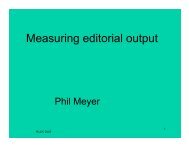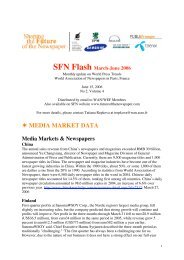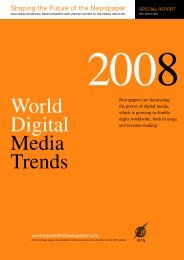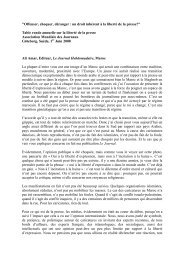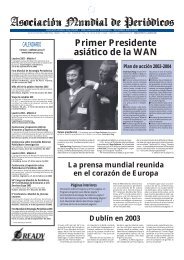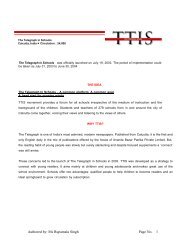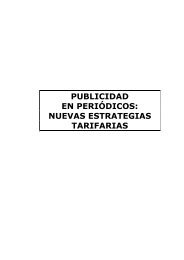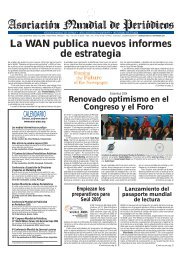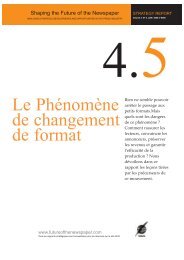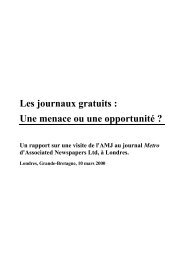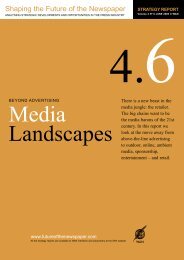WORLD PRESS TRENDS - World Association of Newspapers
WORLD PRESS TRENDS - World Association of Newspapers
WORLD PRESS TRENDS - World Association of Newspapers
You also want an ePaper? Increase the reach of your titles
YUMPU automatically turns print PDFs into web optimized ePapers that Google loves.
TANZANIA<br />
Commentary – Financial Times<br />
Tanzania’s economy is on the growth path, having leaped from<br />
4.8% last year to 5.5% this year. Its per capita income has shot<br />
up from US$210 in 2001 to US$260 presently. The current<br />
inflation rate stands at 4.4%, while the population growth rate<br />
is 2.9%.<br />
The performance <strong>of</strong> newspapers is generally encouraging visà-vis<br />
other media. Electronic media is thinly distributed in a<br />
country whose territory measures about 1,000,000 km 2 , although<br />
FM radios are rising to dominate the scene, but with scanty<br />
advertisement share. Newspaper performance in Tanzania<br />
indicates an important trend. <strong>Newspapers</strong> published in<br />
Kiswahili, especially satirical ones, command large readership,<br />
though less advertisement volume. Kiswahili is a lingua franca<br />
in Tanzania and an <strong>of</strong>ficial language. Every literate person reads<br />
Kiswahili while even illiterates can fluently speak it. There is<br />
no English newspaper that commands 15,000 <strong>of</strong> daily volume<br />
in direct sales in this country. Almost all-English medium<br />
newspapers predominantly depend on advertising income to<br />
survive. There are only two Kiswahili-medium evening<br />
newspapers whose circulation is around 35,000 daily copies.<br />
English readers have acquainted themselves with broadsheets,<br />
and Kiswahili readers with tabloids.<br />
TANZANIA<br />
Over 95%<strong>of</strong> sales are done in the capital city Dar es Salaam<br />
because <strong>of</strong> transport and distribution bottlenecks over the<br />
sprawling country. All the three major publishers are<br />
concentrated in Dar es Salaam, including the government.<br />
Circulation is generally low during rainy season as vendors have<br />
to contend against unfavourable weather. Postal and home<br />
delivery systems are extremely underdeveloped. Online<br />
publications in Tanzania are almost non-existent because <strong>of</strong> lack<br />
<strong>of</strong> territory-wide internet services, though networks are<br />
growing.<br />
Advertising culture in Tanzania shows the following general<br />
annual trends: corporate and institutional advertisers plan their<br />
budgets parallel with the government’s June/July fiscal plan.<br />
Consequently, advertising sales tend to grow gradually from<br />
the month <strong>of</strong> August, stabilise between December-January,<br />
rising up again to attain peaks by April, only to remain constant<br />
budget approval by parliament in June/July.<br />
In December 2001, the Kenyan based Nation Media Group<br />
acquired 60% <strong>of</strong> shares <strong>of</strong> Mwananchi Communications Ltd ,<br />
creating the only media merger in Tanzania.<br />
POPULATION<br />
Population<br />
All individuals Male Female Households<br />
000 % 000 % 000 % 000 %<br />
Mainland 33,585 97 16,428 97 17,157 97 6,811 97<br />
Zanzibar 985 3 483 3 502 3 185 3<br />
Tanzania 34,569 100 16,910 100 17,659 100 6,996 100<br />
Source: 2002 Population and Housing Census General Report, January 2003<br />
Age structure <strong>of</strong> readership<br />
% <strong>of</strong> % within<br />
Age readership age group<br />
15-25 25 10<br />
25-45 65 85<br />
45+ 10 5<br />
Newspaper reach (%)<br />
Daily Monthly<br />
Men 1.5 6.0<br />
Figures above include nondailies<br />
and Sundays<br />
Population by occupational status<br />
%<br />
A 63.2<br />
B 1.9<br />
C 0.6<br />
D 4.1<br />
E 1.9<br />
F 6.1<br />
G 8.5<br />
H 6.2<br />
I 2.8<br />
J 4.6<br />
Total 100<br />
Source: Household Budget Surveys<br />
by National Bureau <strong>of</strong> Statistics, 2001<br />
A = Farming, livestock and fishing<br />
B = Employees/govt.<br />
C = Employees/parastatals<br />
D = Employee: others<br />
E = Self-employment with employees<br />
F = Self-employment without employees<br />
G = Unpaid family helper<br />
H = Housewife/house-maker/household<br />
chores<br />
I = Students<br />
J = Inactive<br />
274<br />
<strong>WORLD</strong> ASSOCIATION OF NEWSPAPERS - <strong>WORLD</strong> <strong>PRESS</strong> <strong>TRENDS</strong> 2003




